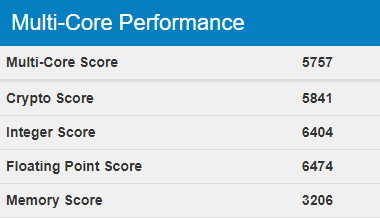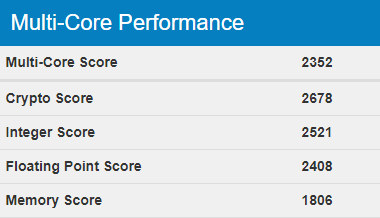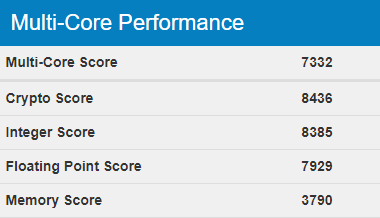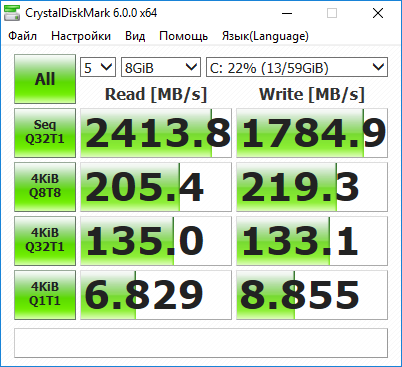Virtual server on VPS.house: performance review
Few people believe in the honesty and impartiality of their own reviews and comparison of the quality of services, but nevertheless, today we offer your attention a completely transparent test of our services, which you can do for free on your own at any time - a test period on any VPS server worth up to 3,000 rubles . per month is free of charge.
VPS.house is a project of the telecommunications company Global Communications Ltd., which provides an opportunity to create a virtual server of almost any desired configuration in a couple of minutes and then freely manage it or a whole pool of servers in your account.
In this test, we compare the work of 2 different configurations: the most minimal (maximum budget) and relatively average cost up to 2000 rubles. per month.
')

In both cases, we will use the most advanced Windows Server 2016.
We set the task of the text to compare performance and usability for the installation of services and applications running 24x7 for both the first and second configurations.
The service does not offer to choose the type of disk (HDD or SSD), but only always indicates that it will be an SSD.
The specified volume of the second configuration should not affect the performance in any way, so choose the volume based on the one you need.
We do not need a video card, protection from DDoS attacks, too.
To do this, we will make several speed measurements at speedtest.net with check points in Moscow, St. Petersburg and somewhere in Germany. The main page claims speeds of up to 250 Mbit / s for each VDS server .
The VPS.house data center in the Moscow military bunker near Korolev, built in the event of a nuclear war, is the best access, respectively, we see in Moscow: 4ms PING to the MGTS point, incoming 788 Mbit / s, outgoing 243 Mbit / c ( link )
St. Petersburg (Vimpelcom): 10ms PING, incoming 507 Mbit / s, outgoing: 250 Mbit / s ( link )
Frankfurt (Vodafone): 50ms PING, incoming 416 Mbit / s, outgoing: 219 Mbit / s ( link )
It feels like using the minimal configuration, the server version with 4 cores, does not feel the “brakes”, but this article is designed to show specific numbers.
For measurement, use Geekbench version 4.2.2 - this utility performs several dozen synthetic tests for computation speed. For clarity, we will perform a similar test on a physical computer with an Intel Core i5-7200 processor and a clock frequency of 2.7 GHz.
On a virtual server, the system sees the Intel Xeon E5-2699 v4 processor with a frequency of 2.2 GHz, we note that the Xeon E5 line is the most powerful CPU option, but since we have a virtual server, then, in accordance with the configurations we chose at the beginning, 1 or 4 virtual cores from this physical processor.
The task of the test is to understand how much the physical processor is overloaded by the customers present besides us, so to speak, to evaluate overselling.
The result of the configuration with 4 cores :

Result of the configuration with the 1st core :

Intel Core i5-7200 result with 4 cores :

The results show that the configuration of a virtual server with 4 cores is almost exactly 2.5 times more productive than a virtual server with 1 core, which is quite typical of multiprocessor systems (there are additional costs for synchronizing tasks in threads). At the same time, the VPS with 4 cores showed a slightly worse result than the physical processor close to it on the i5-7200 - in theory it should be so, because i5 has a 2.7 GHz frequency, in our version of Xeon E5 only 2.2 GHz, You also need to understand that the virtual core is by definition always a little weaker than the physical one.
Thus, the ideal Score result for a test VPS with 4 cores would be
7332 / 2.7 x 2.2 = 5974
Since we received 5757, it turns out that the virtual kernels on VPS.house work only 3% weaker than their original physical capabilities .
To test the speed of work, we use the popular CrystalDiskMark version 6 benchmark - it consistently does a series of tests of random writing and reading with the number of competitive queues from 1 to 32. In the test, we will choose a file size of 8GB, if we take less, then there is a risk that we will measure The speed is not disk, but RAM due to data caching in Windows.
So, the results of the speed of both VPS configurations are expected to be identical :

For comparison, we’ll show the result of the SSD test in the most modern Asus ZenBook premium laptop model:

The speed of the disk when streaming with the number of queue 32 on a virtual server is almost 5 times higher than the results from a modern home PC.
OS loading is a simple and symbolic indicator, directly speaking about how comfortable it is to work with a device or, in our case, a remote server. The time from the moment of clicking “reboot” on the working server to the moment of authorization window display after loading was measured:
• 15 seconds - server reboot time with minimal configuration
• 11 seconds - configuration speed for 1880 rubles.
• 34 seconds - Asus ZenBook reload speed
Decide for yourself if you want the server not to slow down and it was nice to work with it, try taking a free test - now it is given for 3 hours . In essence, this time is enough to assess whether VDS is suitable for one or another provider or not. The interface of the site and personal account is intuitive, the process of creating servers is fully automated - it takes about 3 minutes to get started, no more.
Friends, if you already have a VPS server from any other provider, we will be happy if you carry out similar tests and send screenshots of the results and description of the configuration in the comments - with a sufficient number we will honestly make a rating in a future post!
VPS.house is a project of the telecommunications company Global Communications Ltd., which provides an opportunity to create a virtual server of almost any desired configuration in a couple of minutes and then freely manage it or a whole pool of servers in your account.
In this test, we compare the work of 2 different configurations: the most minimal (maximum budget) and relatively average cost up to 2000 rubles. per month.
')

In both cases, we will use the most advanced Windows Server 2016.
We set the task of the text to compare performance and usability for the installation of services and applications running 24x7 for both the first and second configurations.
The configurations are as follows:
- 1 processor core, 1 GB of RAM and 30 GB disk - the cost is 590 rubles. per month
- 4 processor cores, 4 GB of RAM and 60 GB disk - the cost of 1880 rubles. per month
The service does not offer to choose the type of disk (HDD or SSD), but only always indicates that it will be an SSD.
The specified volume of the second configuration should not affect the performance in any way, so choose the volume based on the one you need.
We do not need a video card, protection from DDoS attacks, too.
We check the network
To do this, we will make several speed measurements at speedtest.net with check points in Moscow, St. Petersburg and somewhere in Germany. The main page claims speeds of up to 250 Mbit / s for each VDS server .
The VPS.house data center in the Moscow military bunker near Korolev, built in the event of a nuclear war, is the best access, respectively, we see in Moscow: 4ms PING to the MGTS point, incoming 788 Mbit / s, outgoing 243 Mbit / c ( link )
St. Petersburg (Vimpelcom): 10ms PING, incoming 507 Mbit / s, outgoing: 250 Mbit / s ( link )
Frankfurt (Vodafone): 50ms PING, incoming 416 Mbit / s, outgoing: 219 Mbit / s ( link )
Check the performance of the processor (CPU)
It feels like using the minimal configuration, the server version with 4 cores, does not feel the “brakes”, but this article is designed to show specific numbers.
For measurement, use Geekbench version 4.2.2 - this utility performs several dozen synthetic tests for computation speed. For clarity, we will perform a similar test on a physical computer with an Intel Core i5-7200 processor and a clock frequency of 2.7 GHz.
On a virtual server, the system sees the Intel Xeon E5-2699 v4 processor with a frequency of 2.2 GHz, we note that the Xeon E5 line is the most powerful CPU option, but since we have a virtual server, then, in accordance with the configurations we chose at the beginning, 1 or 4 virtual cores from this physical processor.
The task of the test is to understand how much the physical processor is overloaded by the customers present besides us, so to speak, to evaluate overselling.
The result of the configuration with 4 cores :

Result of the configuration with the 1st core :

Intel Core i5-7200 result with 4 cores :

The results show that the configuration of a virtual server with 4 cores is almost exactly 2.5 times more productive than a virtual server with 1 core, which is quite typical of multiprocessor systems (there are additional costs for synchronizing tasks in threads). At the same time, the VPS with 4 cores showed a slightly worse result than the physical processor close to it on the i5-7200 - in theory it should be so, because i5 has a 2.7 GHz frequency, in our version of Xeon E5 only 2.2 GHz, You also need to understand that the virtual core is by definition always a little weaker than the physical one.
Thus, the ideal Score result for a test VPS with 4 cores would be
7332 / 2.7 x 2.2 = 5974
Since we received 5757, it turns out that the virtual kernels on VPS.house work only 3% weaker than their original physical capabilities .
Check disk performance
To test the speed of work, we use the popular CrystalDiskMark version 6 benchmark - it consistently does a series of tests of random writing and reading with the number of competitive queues from 1 to 32. In the test, we will choose a file size of 8GB, if we take less, then there is a risk that we will measure The speed is not disk, but RAM due to data caching in Windows.
So, the results of the speed of both VPS configurations are expected to be identical :

For comparison, we’ll show the result of the SSD test in the most modern Asus ZenBook premium laptop model:

The speed of the disk when streaming with the number of queue 32 on a virtual server is almost 5 times higher than the results from a modern home PC.
Operating system reboot speed
OS loading is a simple and symbolic indicator, directly speaking about how comfortable it is to work with a device or, in our case, a remote server. The time from the moment of clicking “reboot” on the working server to the moment of authorization window display after loading was measured:
• 15 seconds - server reboot time with minimal configuration
• 11 seconds - configuration speed for 1880 rubles.
• 34 seconds - Asus ZenBook reload speed
findings
Decide for yourself if you want the server not to slow down and it was nice to work with it, try taking a free test - now it is given for 3 hours . In essence, this time is enough to assess whether VDS is suitable for one or another provider or not. The interface of the site and personal account is intuitive, the process of creating servers is fully automated - it takes about 3 minutes to get started, no more.
Friends, if you already have a VPS server from any other provider, we will be happy if you carry out similar tests and send screenshots of the results and description of the configuration in the comments - with a sufficient number we will honestly make a rating in a future post!
Source: https://habr.com/ru/post/352612/
All Articles